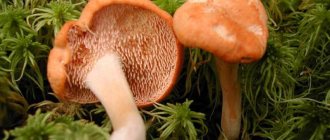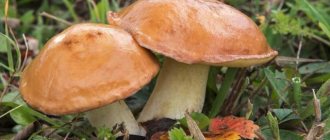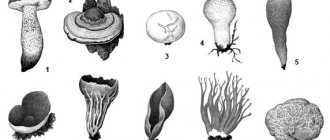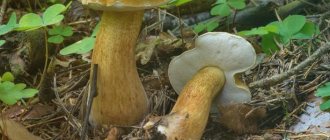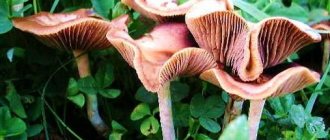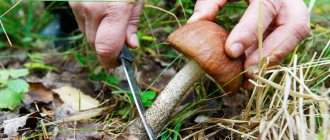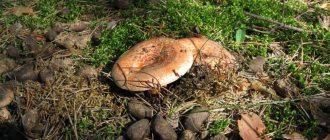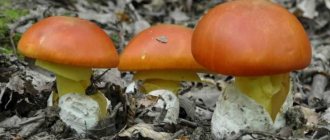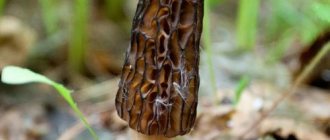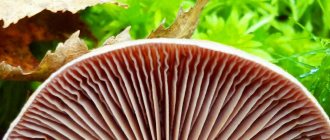In this article, you will learn about the unique healing qualities of lion's mane and its beneficial effects on the body's systems. We will analyze the poisonous varieties of the lepiota mushroom, their structure and harmful or even fatal effects on the body.
Lion's mane contains many trace elements and substances beneficial to the human body, while poisonous lepiota can be fatal to humans.
Lepiota poisonous - a frail but deadly poisonous mushroom
Immature mushrooms have conical caps with a diameter of a centimeter, but as they ripen they become prostrate.
There is a clearly visible brown-red tubercle on the cap. The surface of the mushroom is covered with white skin dotted with sparse brown scales. The shape of the leg is cylindrical.
The color of the leg is fawn, and the base is purple-violet. The height of the leg reaches 5 centimeters, and the diameter up to 0.5 centimeters.
But the leg has a fragile ring. These mushrooms grow not only in forests, but also in steppes, parks, glades, and forest plantations. Bredisson's lepiota begins to actively bear fruit in the fall. Save my details for future comments. Types of mushrooms Edible mushrooms Conditionally edible mushrooms Inedible mushrooms Poisonous mushrooms Hallucinogenic mushrooms. First courses with mushrooms: recipes Second courses with mushrooms Salads with mushrooms Baking with mushrooms, pies, quiche, pizza.
Description of poisonous lepiota
Mushrooms Lepiota mushroom brown-red. Among the kingdom of poisonous mushrooms in the central zone of the Russian Federation, brown-red or chestnut lepiota stands apart. This representative of forest flora poses a mortal danger to humans.
Contents 1 What poisonous lepiots look like 2 Where poisonous lepiots grow 3 Is it possible to eat poisonous lepiots 4 Symptoms of poisoning 5 First aid for poisoning 6 Recommendations for prevention 7 Doubles and their differences 8 Conclusion. The ring is fragile, white in color, and may be absent in adult specimens. Cyanide causes damage to the brain and central nervous system.
Nitriles cause spasm of the respiratory system, leading to paralysis. There is a ring on the leg of Lepiota induspores, which disappears with age.
Toxicity
Lepiota roseata can kill if eaten because it contains high concentrations of toxins that damage or destroy the liver and kidneys.
Fungi in this group contain amatoxins, cyclic peptides consisting of 8 amino acids that stop protein synthesis by inhibiting the necessary enzyme.
Poisoning by mushrooms containing amatoxin is associated with the highest potential morbidity and mortality rates of any group of mushroom poisons. Many deaths occur every year as a result of eating this type of mushroom.
Amatoxins are cyclopeptides that cause widespread liver cell damage and death, causing morbidity and mortality. Amatoxins cause fatty liver degeneration, with centrilobular necrosis. Amatoxins are rapidly absorbed through the intestine, although they may remain in the gastric aspirate for several days, resulting in bile excretion. They are rapidly eliminated through the kidneys and have a half-life of approximately 22 hours.
Description of the structure of a dangerous mushroom
The Latin name of the mushroom is Lepiota helveola. It is also called Lepiota brick red. This is a deadly species that belongs to the Champignon family, genus Lepiota.
The grayish-red cap of the mushroom has a diameter of 2 to 7 cm. At the beginning of the growth of the fruiting body, it is bell-shaped, later it becomes semi-rounded, and by the time of ripening it is flat or, less often, convex-spread. The tubercle in the center is grayish-brown with a cherry tint.
Dark scales are arranged in circles on the cap. By the middle they combine into a complete cover. The plates under the cap are thin, frequent, and free. At first their color is white, then it changes to yellowish-green as the mushroom matures. The spores are colorless.
The cylindrical leg has a diameter of 5 to 8 mm and a height of 2 to 4 cm. It is located centrally and may be slightly curved at the base. Its upper part is light, and its lower part is brown-cherry.
The flesh is white in the cap area and creamy on the stem. Young mushrooms have a pleasant smell and taste. The aroma is usually reminiscent of roasted almonds. As the fruiting body matures, its smell changes and is similar to a mixture of gasoline and kerosene.
https://youtube.com/watch?v=pqAm1SFbcQM%3F
A little history
The mushroom has been known for a long time, but was officially described and classified only in 1889 by the Swiss mycologist Charles-Edouard Martin and the botanist and chemist Robert Hippolyte Stode.
Russian breeds
They are distinguished by a strong physique, good health and excellent production characteristics. When breeding the breeds, the best representatives of the European gene pool were used, thanks to which it was possible to obtain the most universal animals.
Romanovskaya
One of the most common in the whole world. They were bred back in the 18th century in the Yaroslavl region. Despite the fact that they are classified as meat and dairy products, they are usually raised specifically for meat. One female can give birth to up to 5 lambs. Rams gain slaughter weight by 7-8, reaching 90 kg.
Romanovskaya meat breed of sheep
Romanov sheep produce offspring 2-3 times a year, due to which high meat characteristics are achieved. They have a strong physique and powerful bones. The polled appearance and humped head profile are the distinctive features of the breed. Unpretentious to conditions of detention and climate, quickly adapt to any conditions.
Gorkovskaya
The breed was developed by Soviet breeders in the early 20th century by crossing purebred Hampshire sheep with native rams from southern Russia. It is distinguished by coarse and short hair, which is practically not used for sale, but its meat characteristics are considered one of the best among domestic breeds.
Although wool is not used, the meat is quite tasty
An adult ram reaches 110 kg, a sheep is slightly smaller - up to 80. Under optimal housing conditions, fertility can reach 140%. They have exceptional immunity, as well as rapid growth of muscle mass. You may also be interested in information about what kind of fat-tailed sheep there are and what they look like in the photo.
Kuibyshevskaya
A hybrid of domestic breeders, obtained by crossing sheep of the English Romney Marsh breed with aboriginal rams of Transcaucasia. It is distinguished by early ripening, as well as excellent fertility indicators. They have characteristic polled heads and a slightly elongated body.
The elongated body of the animal produces a large amount of meat and wool
North Caucasian
One of the most popular southern parts of Russia. Bred from Stavropol sheep by crossing them with English and American breeds. Adults have fine fleece and are therefore rarely raised for their wool.
At one time, crossing this breed with the European Pitchfork brought unprecedented success and an increase in meat
They have good meat characteristics - with proper maintenance, a ram can reach 120 kg, but females are half that size. They have a strong physique, voluminous muscles and powerful chest. Ways to adapt to any climate
There is also a Kuibyshev breed of sheep, and it is important to find out existing reviews from the owners of this breed
(poisonous umbrella)
or Lepiota brick-red
✎ Affiliation and generic characteristics
Poisonous lepiota (lat. Lepiota helveola), or in other words - brick-red lepiota, or poisonous umbrella - is a species of the genus Lepiota (silverfish) (lat. Lepiota), from the champignon family (otherwise agaricaceae) (lat. Agaricaceae), infinitely large order agaric (lamellar) (lat. Agaricales). Lepiota poisonous belongs to the deadly poisonous species, and contains dangerous cyanide poisons that cause fatal poisoning! This is the opinion that mycologists all over the world almost unconditionally come to.
✎ Similar species
Poisonous lepiota has many similar counterparts and, especially among its relatives, differs from them mainly in its cap of a creamy-white-brown tone with dark scales arranged in concentric circles, connecting in the center and forming a complete cover of brick-purple color. Lepiota squamata can be confused with cystoderm mushrooms (and especially cystoderm red), suitable for consumption (but this is undoubtedly dangerous), from which Lepiota squamata differs in the same scales merging in the center of the cap and forming an inextricable covering of brick-crimson color , which are not present in cystoderms, and the absence of a film ring on the stalk, which is clearly noticeable in cystoderms, and the larger size of the fruiting body.
✎ Brief description and application
Lepiota poisonous belongs to the section of agaric mushrooms and the spores with which it reproduces rest in its plates. The plates are wide, frequent, free, cream-colored with a slightly noticeable greenish tint. The cap is very small, convex or flat-spread, with slightly lowered or bent inward edges, the color of stale meat, covered with dark pressed scales, in the form of concentric circles and zones converging in the center, forming a wide cover of brick-red color. The stem is cylindrical in shape, low and with fibrous remains from a ring in the center, pale cream in color (above the ring at the cap) and dark brick-crimson (under the ring at the base). The pulp is dense, creamy in the cap and upper zone of the stem, red-brownish in the lower part of the stem, with a sweetish odor.
You can’t taste the poisonous lepiota without hesitation, it is deadly poisonous!!!
| ← | ↓ | → |
| Lepiota | |
| Lepiota magnispora | |
| Scientific classification | |
| intermediate ranks Domain: | Eukaryotes |
| Kingdom: | Mushrooms |
| Sub-kingdom: | Higher mushrooms |
| Department: | Basidiomycetes |
| Sub-department: | Agaricomycotina |
| Class: | Agaricomycetes |
| Subclass: | Agaricomycetes |
| Order: | Agariaceae |
| Family: | Champignon |
| Genus: | Lepiota |
(Pers.) Gray, 1821, nom. cons.
| 37314 | |
| EOL | 16457 |
| M.B. | 17938 |
For insects, see Silverfish.
Lepiota
, or
silverfish
(lat. Lepiota) is a genus of mushrooms of the Champignon family (
Agaricaceae
).
Golden phaeolepiot (Phaeolepiota aurea)
- Other names for the mushroom:
- Golden umbrella
- Mustard plaster
- Herbaceous scale
Synonyms:
- Agaricus aureus
- Pholiota aurea
- Togaria aurea
- Cystoderma aureum
- Agaricus vahlii
Description of the mushroom
The cap is 5-25 cm in diameter, in youth from hemispherical to hemispherical-bell-shaped, with age it becomes convex-prostrate, with a small tubercle. The surface of the cap is matte, grainy, bright golden yellow, ochre-yellow, ocher, or an orange tint is possible. The edge of the cap of mature mushrooms may have fringed remains of a private veil. The graininess of the cap is more pronounced at a young age, even scaly; with age it decreases, even disappearing. At a young age, along the edge of the cap, at the place where the veil is attached, a stripe of a darker shade may appear.
The flesh is white, yellowish, the stem may be reddish. Thick, meaty. Without any special smell.
The plates are frequent, thin, curved, and adherent. The color of the plates ranges from whitish, yellowish, pale ocher, or light clay when young, to rusty brown in mature mushrooms. In young mushrooms, the plates are completely covered with a dense filmy covering of the same color as the cap, perhaps a slightly darker or lighter shade.
The spore powder is rusty brown. Spores are oblong, pointed, 10..13 x 5..6 µm in size.
The leg is 5-20 cm high (up to 25), straight, with a slight thickening at the base, possibly widened in the middle, granular, matte, longitudinally wrinkled, at a young age smoothly turning into a partial cover, also granular, radially wrinkled. At a young age, the graininess is very pronounced, even scaly. The color of the leg is the same as that of the bedspread (like the cap, perhaps a darker or lighter shade). With age, the bedspread bursts, leaving a wide, hanging ring on the leg, the color of the leg, with brown or brown-ocher scales that can cover almost, or even its entire area, giving the bedspread a completely brown appearance. With age, as the mushroom ages, the ring noticeably decreases in size. Above the ring, the leg is smooth, at a young age it is light, the same color as the plates, there may be whitish or yellowish small flakes on it, then, with the maturation of the spores, the plates begin to darken, the leg remains lighter, but then it also darkens, reaching the same rusty-brown color as the blades of an old mushroom.
Habitat
Golden pheolepiote grows from the second half of July until the end of October, in groups, including large ones. Prefers rich, fertile soils - meadows, pastures, fields, grows along roads, near nettles, near bushes. It can grow in clearings in light deciduous and larch forests. The mushroom is considered rare and is listed in the Red Book of some regions of Russia.
Similar species
This mushroom has no similar species. However, in photographs, when viewed from above, the pheolepiote can be confused with an annular cap, but this is only in photographs, and only when viewed from above.
Edibility
Previously, golden pheolepiote was considered a conditionally edible mushroom, which was eaten after boiling for 20 minutes. However, now the information is contradictory; according to some data, the mushroom accumulates cyanide and can lead to poisoning. Therefore, recently, it has been classified as an inedible mushroom. However, no matter how hard I tried, I could not find information about anyone being poisoned by it.
Photo: from the questions in the Determinant.
Yellow-skinned champignon (Agaricus xanthodermus)
Its other name is yellow-skinned pecheritsa. The mushroom is common in forests, as well as city parks and squares, where it grows rapidly after rains.
Yellow-skinned champignon. Photo from wikigrib.ru
The cap of adult mushrooms is wide, bell-shaped, white or light gray. The leg is from 6 to 15 cm long, white, at the bottom it has a thickening with a white two-layer ring. When cooking, a strong carbolic (“pharmacy”) smell appears, which is quite unpleasant.
The mushroom is poisonous, but not fatal. Pecheritsa is somewhat similar to other champignons , for example, sh. ordinary and field , but it can be easily distinguished by its smell during the cooking process.
Definitioner
Basidia (Basidia)
Lat. Basidia. A specialized structure of sexual reproduction in fungi, unique to basidiomycetes. Basidia are terminal (end) elements of hyphae of various shapes and sizes, on which spores develop exogenously (outside).
Basidia vary in structure and method of attachment to hyphae.
Based on the position relative to the axis of the hyphae to which they are attached, three types of basidia are distinguished:
Apical basidia are formed from the terminal cell of the hypha and are located parallel to its axis.
Pleurobasidia are formed from lateral processes and are located perpendicular to the axis of the hypha, which continues to grow and can form new processes with basidia.
Subbasidia are formed from a lateral process turned perpendicular to the hyphal axis, which stops growing after the formation of one basidium.
Based on morphology:
Holobasidia are single-celled basidia, not divided by septa (see Fig. A, D).
Phragmobasidia are divided by transverse or vertical septa, usually into four cells (see Fig. B, C).
By type of development:
The heterobasidium consists of two parts - the hypobasidium and the epibasidium developing from it, with septations (see Fig. C, B) or without them (see Fig. D).
Homobasidia is not divided into hypo- and epibasidia and in all cases is considered to be holobasidium (Fig. A).
The basidium is the site of karyogamy, meiosis, and the formation of basidiospores. Homobasidy, as a rule, is not functionally divided, and meiosis follows karyogamy. However, the basidia can be divided into probasidium, the site of karyogamy, and metabasidium, the site of meiosis. Probasidium is often a resting spore, for example in rust fungi. In such cases, the probasidium germinates into a metabasidium, in which meiosis occurs and on which basidiospores are formed (see Fig. E).
See Karyogamy, Meiosis, Hypha.
Pileipellis
Lat. Pileipellis, skin - a differentiated surface layer of the cap of agaricoid basidiomycetes. The structure of the skin in most cases differs from the inner flesh of the cap and may have a different structure. The structural features of pileipellis are often used as diagnostic characters in descriptions of fungal species.
Based on their structure, they are divided into four main types: cutis, trichoderma, hymeniderma and epithelium.
See Agaricoid fungi, Basidiomycete, Cutis, Trichoderma, Hymeniderma, Epithelium.
Pileipellis (Pileipellis)
Lat. Pileipellis, skin - a differentiated surface layer of the cap of agaricoid basidiomycetes. The structure of the skin in most cases differs from the inner flesh of the cap and may have a different structure. The structural features of pileipellis are often used as diagnostic characters in descriptions of fungal species.
Based on their structure, they are divided into four main types: cutis, trichoderma, hymeniderma and epithelium.
See Agaricoid fungi, Basidiomycete, Cutis, Trichoderma, Hymeniderma, Epithelium.
Description of Lepiota
In order to recognize the lepiota mushroom, you only need to read the description once. The photo of lepiota in our photo gallery below will help you consolidate the result. The characteristic appearance includes a thin cap wall and a flexible, fibrous stalk.
The cap can grow up to 7 cm in diameter. Color - cherry shade of brown, red or brown. On the outer surface of the cap, scales are attached in the form of centric circles, which are distinguished by a more saturated color. On the back side of the cap you can find thin plates that are located at a sufficient distance from each other. They have a slight yellowish tint. In the adult state, a white powder is released, saturated with cylindrical spores.
If these spores enter the human respiratory tract, they can cause severe damage to bronchial and pulmonary tissue.
The diameter of the lepiota leg does not exceed 4 mm with a length of no more than 4 cm. It is quite flexible and consists of weakly fibrous tissue, which is quite difficult to break. Some individuals have a dense white ring approximately in the middle.
The leg itself is cherry in color. Dense light scales can be detected, which accumulate in large quantities at the base of the fungus. If the leg of lepiota is cut in half, a light fruity aroma will be felt. When oxidized by ambient air, this odor quickly disappears and gives way to the tones of acetone and kerosene.
It is worth closely monitoring children who are walking in park areas. Usually these mushrooms are found in places where people often step. In particular, in parks and walking areas, these are quite common representatives of the fungal flora.
Galerina marginata
Mushrooms usually grow in small groups in forests on heavily rotted tree trunks throughout the summer. The mushroom cap is 1-4 cm in diameter, the color is dirty yellow-brown, and gradually becomes almost flat from bell-shaped-convex. The leg is 2-5 cm long, thin, thickened at the bottom, with a yellowish ring, above which it seems to be sprinkled with a powdery coating.
Galerina bordered. Photo from wikigrib.ru
One of the especially poisonous mushrooms. The fringed galerina can be confused with the summer honey fungus .
Poisonous lepiota
Category: inedible.
Cap (diameter 3-7 cm): usually reddish or brown, with a central tubercle. Young mushrooms have a bell-shaped or cone-shaped shape, while older mushrooms have a prostrate shape. Dry, which is why it is often covered with cracks and yellow or brownish scales.
Leg (height 3-10 cm): yellow or light cream, tapering from bottom to top, cylindrical, very thin and hollow. Young mushrooms have a white ring that disappears over time.
Pulp: fibrous, white. Very sour with an extremely unpleasant chemical smell.
Lookalikes: Lepiota relatives lilac (Lepiota lilacea), chestnut (Lepiota castanea) and woolly boot (Lepiota clypeolaria). The lilac lepiota is extremely poisonous, has purple scales, while the chestnut and woolly booted ones have larger and darker scales on their caps.
Eating: not consumed.
Use in folk medicine: not used.
Comb lepiota grows from the beginning of July to the end of September in temperate countries of the Northern Hemisphere.
Other names: comb umbrella, comb silverfish.
Where it can be found: on the soils of coniferous and mixed forests, on the edges or along roads. Especially often, Lepiota comb grows next to pine trees.
Panther or gray fly agaric (Amanita pantherina)
Found in the second half of summer and autumn. The cap of the mushroom is up to 12 cm in diameter; in youth it is bell-shaped, but then becomes prostrate. Its color varies from light brown to olive, the entire surface is strewn with multiple white spots. The flesh is also white with a repulsive odor.
Panther fly agaric. Photo from wikigrib.ru
The thin and hollow stalk reaches 13 cm in length. It narrows at the top and thickens at the bottom. The mushroom is similar to the harmless gray-pink fly agaric , but it is deadly poisonous. Poisoning occurs quickly: within 20 minutes to 2 hours after eating.
Localized mushrooms that promote gastrointestinal distress
Purple boletus
The purple boletus mushroom from the genus Boletus is considered poisonous, so it is worth knowing it by sight in order to distinguish it from edible boletus mushrooms. The cap of the mature fruiting body of the purple boletus reaches 25 centimeters, is shaped like an irregular hemisphere, and is rough to the touch. The reddish color of the cap may have a brown or olive tint.
If you press on the cap, dark blue spots will appear. It is often damaged by insects and lemon-yellow flesh is visible in these places. The flesh of the young fruiting body is hard; when damaged, it changes color to black and blue, and later acquires a wine tint. The taste of the mushroom pulp is sweetish, the smell is weak, sourish-fruity. The stem of the mushroom rises 15 cm in height with a thickness of up to 10 cm, its shape resembles a barrel, brown in color with a pronounced red tint. Occurs relatively rarely from June to September. Loves hilly and mountainous areas with a warm climate, deciduous forests (oak, beech) with calcareous soils. Fruits in June-September.
Volnushka pink
Volnushka pink
Pink volnushka, from the genus of laticifers, belongs to the conditionally edible mushrooms. However, improperly prepared mushrooms can cause quite serious intestinal upset. Therefore, if you don’t want to take risks, then it’s better to remember what a pink wave looks like and avoid it.
The flat cap with a depression in the central part, up to 12 cm in diameter, is gray-pinkish and can fade to a white-pink hue. Darkens when touched. The surface of the cap is slightly slimy to the touch. The cylindrical solid stalk, up to 6 cm in height and about 2 cm in thickness, is initially dense, and then a cavity forms in it.
The dense white pulp has a pungent taste and, like all milkweeds, produces juice. It is white in color, which does not change over time. The most massive growth of fruiting bodies is observed in August-September. An inexperienced mushroom picker may confuse the pink molewort with the white molewort, prickly milkweed, true saffron milkweed or spruce milkweed.
False fox
False fox
False chanterelle is considered a conditionally edible mushroom in some sources, and poisonous in others. Therefore, it is better not to take this mushroom into the basket. There are edible chanterelles. And you need to learn to distinguish a false chanterelle from its edible sister.
The cap of the mature fruiting body of the false chanterelle has a diameter of 2-5 cm, convex or funnel-shaped, golden or yellowish in color, while the cap is darker in the center than at the edges. The flesh of the mushroom is yellow with an orange tint and an unpleasant odor.
The main feature by which it can be distinguished from a real chanterelle is the leg, which in a false chanterelle is reddish with a characteristic orange tint and somewhat thinner than that of a real chanterelle. Found in mixed forests, the fruiting bodies ripen in August-November.
White row
White row
White row is a poisonous, inedible mushroom. When consumed, it causes intestinal upset. The cap is a dull gray-white color. In young fruiting bodies it is convex in shape, and as it matures it becomes prostrate and convex. The center is brown-yellow, with ocher spots, thick, fleshy, white flesh. Young fruiting bodies have no odor. During the ripening process, an unpleasant odor appears, slightly reminiscent of the smell of radish.
Satanic mushroom
Satanic mushroom
The satanic mushroom from the genus Borovik is a poisonous mushroom, the consumption of which can lead to serious poisoning. In appearance, the satanic mushroom is similar to other boletus mushrooms, primarily to the first-class porcini mushroom, so you need to know its main distinguishing features.
The white or slightly yellowish flesh turns blue or red when broken. Young fruiting bodies have a slightly spicy odor, while old ones have an unpleasant odor, like rotten onions. The spherical or barrel-shaped dense leg is red-yellow at the top, reddish in the middle, and reddish-orange at the bottom.
You can also check out: Edible mushrooms
The satanic mushroom prefers broad-leaved forests (oak, beech, hornbeam, chestnut) with calcareous soils. The fruiting bodies ripen in June-September.
Prevention recommendations
To avoid poisoning, you need to collect mushrooms correctly:
- unknown or questionable specimens do not need to be picked;
- mushrooms grown in garbage bins, city landfills, along highways and near chemical plants cannot be collected or processed. Fruiting bodies quickly absorb toxic substances and can therefore cause poisoning;
- overgrown or damaged ones are also better left in the forest. Poisoning often occurs when consuming old edible mushrooms;
- Small children should not be taken to mushroom picking. They often pull into their mouths whatever they like, for example, a red fly agaric cap;
- You cannot purchase mushrooms from people selling in spontaneous markets along highways;
- processing technology must be strictly followed. Conditionally edible specimens are boiled twice, for at least 20 minutes each time, the water is not reused.
Kinds
- Lepiota adusta (E. Horak) E. Horak, 1980
- Lepiota alopochroa (Berk. & Broome) Sacc., 1887
- Lepiota aspera (Pers.) Quél., 1886
- Lepiota bickhamensis P.D. Orton, 1984
- Lepiota boertmannii Knudsen, 1980
- Lepiota boudieri Bres., 1885
- Lepiota brunneoincarnata Chodat & C. Martín, 1889
- Lepiota brunneolilacea Bon & Boiffard, 1972
- Lepiota calcarata (E. Horak) E. Horak, 1980
- Lepiota calcicola Knudsen, 1980
- Lepiota carinii Bres., 1929
- Lepiota castanea Quél., 1881
- Lepiota cingulum Kelderman, 1994
- Lepiota citrophylla (Berk. & Broome) Sacc., 1887
- Lepiota clypeolaria (Bull.) P. Kumm., 1871
- Lepiota coxheadii P.D. Orton, 1984
- Lepiota cristata (Bolton) P. Kumm., 1871
- Lepiota cystophoroides Joss. & Riousset, 1972
- Lepiota echinacea JE Lange, 1940
- Lepiota echinella Quel. & G. E. Bernard, 1888 – Lepiota chaetosa
- Lepiota efibulis Knudsen, 1981
- Lepiota erminea (Fr.) Gillet, 1874
- Lepiota exstructa (Berk.) Sacc., 1887
- Lepiota felina (Pers.) P. Karst., 1879
- Lepiota forquignonii Quél., 1885
- Lepiota fuscovinacea F.H. Møller & J.E. Lange, 1940
- Lepiota grangei (Eyre) J. E. Lange, 1935
- Lepiota griseovirens Maire, 1928
- Lepiota helveola Bres., 1882 - Lepiota poisonous
- Lepiota hymenoderma D. A. Reid, 1966
- Lepiota hystrix FH Møller & JE Lange, 1940
- Lepiota ignivolvata Bousset & Joss. ex Joss., 1948
- Lepiota jacobi Vellinga & Knudsen, 1992
- Lepiota lateritiopurpurea Lar.N. Vassiljeva, 1973 – Lepiota brick-purple
- Lepiota lilacea Bres., 1892
- Lepiota locquinii Bon, 1985
- Lepiota magnispora Murrill, 1912
- Lepiota medullata (Fr.) Quél., 1872
- Lepiota mesomorpha (Bull.) Gillet, 1874
- Lepiota metulispora (Berk. & Broome) Sacc., 1887
- Lepiota micropholis (Berk. & Broome) Sacc., 1887
- Lepiota neophana Morgan, 1906
- Lepiota nigromarginata Massee, 1902
- Lepiota obscura (Locq. ex Bon) Bon, 1958
- Lepiota ochraceofulva P.D. Orton, 1960
- Lepiota oreadiformis Velen., 1920
- Lepiota parvannulata (Lasch) Gillet, 1874
- Lepiota perplexa Knudsen, 1981
- Lepiota phlyctaenodes (Berk. & Broome) Sacc., 1887
- Lepiota pseudoasperula (Knudsen) Knudsen, 1980
- Lepiota pseudofelina JE Lange, 1940
- Lepiota pseudolilacea Huijsman, 1947
- Lepiota purpurata (G. Stev.) E. Horak, 1980
- Lepiota rubella Bres., 1890
- Lepiota rufipes Morgan, 1906
- Lepiota subalba Kühner ex PD Orton, 1960
- Lepiota subgracilis Wasser, 1978
- Lepiota subincarnata JE Lange, 1940
- Lepiota tomentella JE Lange, 1923
- Lepiota virescens (Speg.) Morgan, 1906
- Lepiota xanthophylla P. D. Orton, 1960
Poisonous umbrella mushrooms
Among the numerous genus Macrolepiot there are specimens that are almost no different from edible ones in appearance, but are considered poisonous. These include the combed, chestnut, fleshy-red, brown-red and rough umbrella. The most dangerous are the first 2 types.
Chestnut
Lepiota chestnut has a red or brown cap, the diameter of which does not exceed 4 cm. The cap of the chestnut umbrella mushroom at a young age has an ovoid shape, then takes on the appearance of an outstretched dome. A small bump remains in the center. Gradually, the skin of the cap cracks, small scales of a brownish color are formed.
As they grow, the plates turn yellow. The reddish or brown pulp is highly fragile and has an unpleasant odor. The leg is in the shape of a narrow cylinder, widening closer to the base. The ring is white, but gradually becomes thinner and completely disappears.
The chestnut umbrella is very poisonous; in most cases, eating this product ends in death.
Comb
The cap of young umbrellas has the shape of a bell, later it becomes like a wide dome with a diameter of up to 10 cm. Its surface is red-brown or dark brown, covered with orange or yellow scales with sharp tips.
The leg in the upper part is cylindrical, hollow, thin, 7-10 cm high and no more than 5 mm in diameter. It has a variety of tones - from yellow to cream, but can also have a brown tint. In young specimens, the wide membranous ring is clearly visible, white or pink, but quickly disappears as it grows.
The pulp of the mushroom is white and has an unpleasant odor and taste.
Lepiota comb is a poisonous species and is not eaten.
Rough
The cap of Lepiota roughis can reach 15 cm in diameter and is bell-shaped. As it matures, it becomes prostrate or convex, with a wide tubercle in the central part. The surface of the cap is very dry, reminiscent of felt. Color - from yellowish to light brown. The scales are darker, pyramidal in shape, and large.
The plates of the umbrella mushroom are under a white blanket, which later transforms into a thin, white, cobwebby ring with brown scales on the lower part. The color of the plates ranges from white to cream.
The stem, which has a tuberous shape at the base, is thin (10-15 mm) and long (up to 12 cm), hollow. Above the ring it is distinguished by a light shade, below it it is yellow or brownish, fibrous, covered with scales, and cylindrical in shape.
The pulp of rough lepiota has an unpleasant, strong resinous odor and bitter taste. Not used for food.
Pale grebe (Amanita phalloides)
It belongs to the category of deadly poisonous mushrooms. Its habitat is forests located in the southern regions of the country, where it is found throughout the summer and early autumn.
The mushroom is quite large, forms a wide cap 10-15 cm in diameter, convex, pale greenish-olive in color. Young toadstools resemble champignons due to the downward curved edges of the cap, which later becomes almost flat.
Death cap. Photo from the site birbaskaistanbul.blogspot.ru
The leg of the toadstool is white, stretches up to 12-15 cm in length. Just below the cap there is a characteristic ring resembling a fringed skirt, and at the very bottom of the stem there is a thickening. The mushroom has no smell or taste. Pale toadstool is a bit reminiscent of edible mushrooms such as russula and champignons; if you lack experience, they can easily be confused. Even eating 1/3 of the mushroom causes fatal poisoning, and no processing methods eliminate the toxic effect. The danger also lies in the fact that signs of poisoning appear no earlier than 6 hours after consumption, and sometimes even after 2 days.
How to distinguish an edible umbrella from an inedible purple mushroom
There is another false umbrella that can also be confused. How to distinguish the edible umbrella mushroom from the inedible one - the purple umbrella? The inedible purple mushroom has a corresponding color, bitter taste and unpleasant odor. Although this fruiting body is not poisonous, it is not recommended to eat it due to its strong bitterness. We invite you to look at a visual photo of the inedible umbrella mushroom:
It is worth noting that umbrella mushrooms are very common among representatives of the mushroom kingdom. Since they grow on decaying organic debris, on rotting plants, they are also called saprophytes. Sometimes umbrellas can reach very large sizes, for example, the cap in diameter can be more than 23 cm, and the height of the stem can be up to 30 cm. Umbrella mushrooms grow in circles, forming rings, popularly called “witch circles.” In such circles, umbrellas can grow to several dozen.
Signs of poisoning and first aid
The danger of the mushroom to humans is not only when it is consumed as food. Inhalation of its spores causes severe damage to the tissues of the lungs and bronchi. When the fruiting body is ingested, symptoms of poisoning develop within 10 minutes. A lethal dose of toxins will be obtained by eating just one mushroom cap.
Even with urgent medical attention, 50% of those poisoned die. Hemodialysis and blood transfusions are used in treatment, but these methods are also not effective enough.
The clinical picture is developing rapidly. Death occurs within 30–60 minutes from the moment the first symptoms appear, which is why medical care is often simply ineffective. The main manifestations of poisoning are the development of convulsions and the release of copious foam from the mouth due to rupture of the alveoli.
There are no effective first aid methods due to the rapid absorption of toxins in the intestines. Taking sorbents and gastric lavage do not bring results. The only thing that increases the victim’s chances of survival is calling an ambulance at the first signs of poisoning.
Description of poisonous lepiota
The shape of the cap of the poisonous lepiota is round, with a barely noticeable tubercle visible in the center. There are very thin radial grooves on the surface of the cap. The color of the cap is gray-red. Its surface is matte with a silky sheen. The cap is strewn with a large number of pressed scales. Its diameter does not exceed 2-7 centimeters.
The leg is low, central, cylindrical in shape. There is no thickening in the leg. It is hollow and fibrous inside. The color of the legs is pink. Its height is 2-4 centimeters. There is a very fragile whitish ring on the stem that often falls off.
The plates are concave, often located. The flesh is white, turning slightly pink when cut. The pulp has a sweetish odor, but is tasteless. The spores are white.
Variability of Lepiota poisonosa
The color of the poisonous lepiota cap varies from pink to brick red. The color of the plates is cream or white. The leg may be pink or red-brown.
Places of growth and season of poisonous lepiota
Poisonous lepiota can be found from June to August. These mushrooms grow in Western Europe and Ukraine. They settle among the grass - in meadows and parks.
Similar species
Lepiota poisonous is similar in appearance to other types of small lepiota. All small-sized lepiots should be treated with great suspicion.
Toxicity of lepiota poisonosa
This is an extremely poisonous mushroom, to be more precise, a deadly poisonous species. The only good news is that these mushrooms are frail and unsightly in appearance, and their sizes are small, so they do not attract mushroom pickers.
Other mushrooms of this genus
Lepiota spores or Umbrella is a poisonous mushroom. His hat is small, measuring 3-6 centimeters. With age, it changes from hemispherical to prostrate, while retaining the characteristic tubercle. The color of the cap is beige, white-yellow or reddish. The surface of the cap is covered with scales. The pulp is yellowish in color with a pleasant mushroom aroma. The leg is quite thin - its diameter does not exceed 0.5 centimeters, and its length is 5-8 centimeters. There is a ring on the stem, but it quickly disappears.
Lepiota spores is a rare mushroom. These mushrooms bear fruit from August to September. They grow in forests of various types. Most often found in small groups.
Bredisson's lepiota is a poisonous mushroom. Immature mushrooms have conical caps with a diameter of 2-4 centimeters, but as they ripen they become prostrate. There is a clearly visible brown-red tubercle on the cap. The surface of the mushroom is covered with white skin dotted with sparse brown scales. The shape of the leg is cylindrical. The color of the leg is fawn, and the base is purple-violet. The height of the leg reaches 5 centimeters, and the diameter up to 0.5 centimeters. But the leg has a fragile ring.
These mushrooms grow not only in forests, but also in steppes, parks, glades, and forest plantations. Bredisson's lepiota begins to actively bear fruit in the fall.
Among poisonous mushrooms, there are those species that pose a mortal danger and those that disturb the condition of the victim for some time. Lepiota poisonous belongs to the first category and can kill the one who eats it
Because of this, it is important for a lover of quiet hunting to know exactly how to distinguish this species from its edible counterparts
Looking for silverfish
You should start your search from the dampest places in your home: bath, toilet, kitchen. Inspect various cracks especially carefully - thanks to their narrow body, these insects can climb anywhere. It is also necessary to carefully examine closets with old clothes. These insects can usually be easily detected by simply turning on the light in the bathtub or toilet at night. But if you only have a small group of silverfish, then you will have to look for them using additional signs:
Litter. Silverfish droppings look like small black peppercorns; Leather. During molting, insects shed scales of their skin, which are easy to detect if you look closely; Harm
Pay attention to the wallpaper or cardboard boxes that are on the floor. If there are small round holes in them, then this is the first sign that silverfish have settled in your home.
Appearance of a mushroom umbrella
To understand what an umbrella mushroom looks like, let’s take a closer look at this issue. There are several varieties of the mushroom and they all have different external descriptions.
The red umbrella mushroom, another name is the shaggy umbrella mushroom. This species has a large fleshy cap up to 20 cm in diameter. The surface color is uneven: darker gray-brown in the center, whitish at the edges. The cap has circular scales. The size of the leg can reach 25 cm, it is hollow and smooth. Young mushrooms have a white stem, old mushrooms have a white stem. If you press on the plates, you can notice a color change to red-orange.
Girlish umbrella mushroom. This is a rare trophy that requires careful handling. It is quite difficult to see it in nature; an external representation can be obtained from a photo (Fig. 1). The fungus itself is distinguished by a beautiful rounded cap: frequent scales of a delicate nut color give it a special attractiveness. It is small in size: the cap is up to 10 cm, the leg is about 12 cm. The plates are often free with a smooth edge. Experienced mushroom pickers claim that if you cook the caps with eggs, the description of the taste of the dish is reminiscent of chicken.
Chestnut is a poisonous umbrella mushroom. It is small in size, the cap is no larger than 4 cm (Fig. 2). In a young fungus, the cap resembles an egg in shape; subsequently it straightens out and becomes flat with a tubercle in the center. Description of scales: bright, brown-chestnut. The leg is thin, hollow, chestnut in color. Chestnut umbrellas grow in families and are common in the forests of central Russia. These bright little fungi are deadly poisonous.
The umbrella is colorful. Such an umbrella is difficult not to notice and pass by: it is large (Fig. 3). The diameter of the cap reaches 38 cm; gray-brownish fibrous scales are formed on a white background. The ball-shaped cap of a young mushroom opens into a cone with age. There is a dark tubercle in the center, and the edges curve inward. The base-leg is brown with a ring of small scales. The pulp is loose with a specific pronounced aroma. The large umbrella is close in taste to champignons.
White or spring fly agaric (Amanita verna)
Throughout the summer, the spring fly agaric grows in the forests. The cap is white, up to 10 cm in diameter, semi-prostrate in shape with a slightly ribbed edge. The pulp has an unpleasant odor.
White fly agaric. Photo from wikigrib.ru
The leg is also white, 7-12 cm long, hollow, covered with flake-like scales, and has a swelling in the lower part. The ring on the stem is wide, slightly striped.
The mushroom belongs to the class of deadly poisonous. It can easily be confused with a white float , but it should be remembered that the latter does not have a ring and has no smell.
Description of Lepiota rosea
The cap of Lepiota rosea has a diameter of 2-5 centimeters; its shape is convex-spread or flat-spread. The edges of the cap are slightly curved inward. Its color is ocher-pink. The surface of the cap is completely covered with tightly pressed scales. The color of the plates is wine brown.
Lepiota rosea is a lamellar mushroom. The plates are free, very frequent, and wide. The color of the plates is cream with a slight greenish tint. The pulp is dense. The color of the flesh of the cap and the upper part of the leg is cream-colored, and the lower part of the leg is a meat color.
The leg of the serrated umbrella is cylindrical, of average length - 2.5-4 centimeters and with a diameter of up to 0.35 centimeters. In the middle of the leg there is a characteristic fibrous ring. Above the ring, the leg is light gray, and its lower part is dark gray.
Externally, lepiots are very similar to umbrella mushrooms, but are smaller in size. And the rest of the generic characteristics (a cap that looks like an open umbrella, fibrous scales and a stationary ring on the stem) are completely the same for these mushrooms.
Places of distribution of serrated umbrellas
Serrated umbrellas are common in Western Europe: France, Belgium, Italy, Denmark, Hungary, Germany, Great Britain, as well as in Russia and Kazakhstan. These mushrooms grow among grass, in meadows. Active growth of Lepiota rosea is observed from mid-June to the end of August. Lepiots are saprophytes, meaning they feed on decaying debris in the soil.
Toxicity of Lepiota rosea
This mushroom should never be tasted - lepiota rosea is a deadly poisonous species, it contains cyanides that cause serious poisoning.
Similar species
There are approximately 50 species in the genus, with 7 species classified as poisonous and 3 as deadly poisonous, and there are also little-known edible species in the genus, for example, the parasol. But lepiots are very difficult to distinguish, and since there are deadly poisonous species in the genus, it is recommended not to collect these mushrooms at all.
Related species
The following species grow on the territory of Russia and Europe:
- Lepiota chestnut has a cap with a diameter of 2-4 centimeters. At first its shape is almost ovoid, but over time it becomes flat. The color of the cap is yellow-brown or red-brown with chestnut-colored felt scales. The length of the leg is 2-5 centimeters. These mushrooms bear fruit from July to September. They grow in forests, gardens, and along ditches. Rarely seen. They live in groups.
- Lepiota poisonous has a rounded cap with an unpronounced tubercle. The color of the cap is gray-red. The surface of the cap is matte with a large number of pressed scales. The leg is low, cylindrical, pink in color. It has a very fragile whitish ring on it. These mushrooms are found from June to August. They grow in Western Europe, Ukraine. You can find them among the grass in meadows and parks. This is a rare species. It bears fruit exclusively in autumn.
- Lepiota rougha, Lepiota combata, Lepiota swellspore and Lepiota thyroid are highly suspected of being poisonous;
- Leptiota redplate is an edible mushroom;
- Lepiota corypus is classified as a conditionally edible mushroom that is suitable for frying and boiling.
Features, time and place of fruiting
The species is found in most European countries, Kazakhstan, Algeria, and Morocco. In Russia it grows only in Crimea.
There are no officially confirmed cases of its spread in the country outside the peninsula.
Fruiting begins in August and ends by mid-autumn. The maximum number of fruiting bodies is formed in September.
The mushroom can grow either singly or in groups. It is found in bamboo forests, forest parks with mixed deciduous and coniferous trees, squares and gardens. In terms of toxicity, the mushroom is superior to the toadstool.
